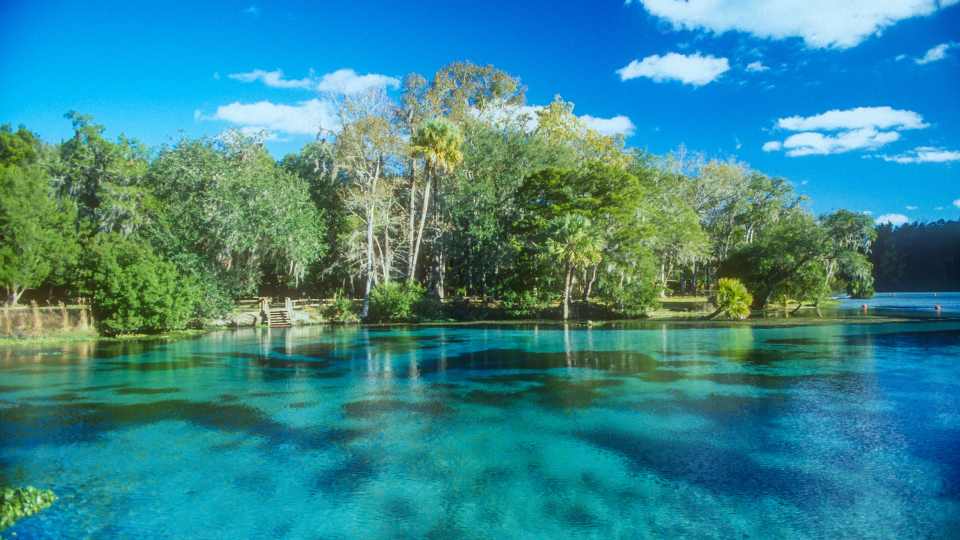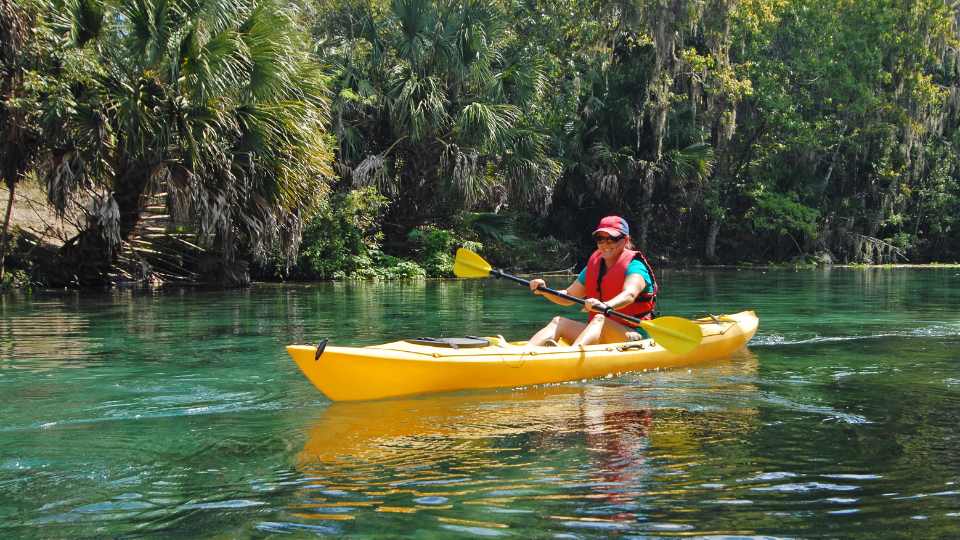
Florida’s landscape is dotted with a remarkable collection of natural springs, offering a window into a unique underwater world. With over 700 recognized springs throughout the state, these natural fountains are a testament to the extensive aquifer systems running beneath the Floridian surface.
From the world-renowned magnitude of Wakulla Springs to the family-favorite Manatee Springs, each offers a spectacular view of crystal-clear water and diverse ecosystems.
The allure of Florida’s springs lies not only in their beauty but also in their variety. Some springs, like the popular Ginnie Springs, are known for their clear waters that attract snorkelers and divers. Others, such as Devil’s Den and the Rainbow River, are steeped in both natural splendor and recreational appeal, drawing crowds eager to swim, kayak, and connect with nature.
These springs are more than just picturesque swimming holes; they are windows to the state’s geological and ecological diversity. They serve as critical habitats for a variety of wildlife, including the endangered manatee, and play a vital role in the local ecology.
As Florida continues to develop and its population grows, the conservation and preservation of these natural springs remain a crucial aspect of protecting the state’s environmental heritage.
About Florida’s Springs
Florida’s springs are fed by intricate groundwater systems and are shaped by the state’s unique karst topography. These geological characteristics are fundamental in the formation and sustainability of the numerous springs throughout the state.
Karst Topography
Karst topography is a landscape formed from the dissolution of soluble rocks, including limestone, which is abundant in Florida. The dissolution process is due to the natural acidity of rainwater as it percolates through the soil and into the rock. This results in:
- Sinkholes: When the limestone dissolves, it often creates sinkholes, a common feature in karst landscapes.
- Caves and Fissures: The dissolving limestone can also lead to the formation of underground voids and conduits, which can create caves and passageways for water flow.
Aquifer Systems
The aquifer systems in Florida are highly influenced by the karst topography.
- Floridan Aquifer: It is one of the world’s most productive aquifers and is the primary source feeding the springs in Florida.
- Composition: Limestone and dolomite make up the aquifer and facilitate water movement due to their porosity.
- Spring Vents: Where the aquifer is close to the earth’s surface or pressure is sufficient, water rushes to the surface, creating spring vents and the emergence of a spring.
By understanding these geologic features, one can better appreciate the dynamics and vulnerabilities of Florida’s natural springs.

Major Springs of Florida
Florida’s natural springs are not only ecological treasures but also offer crystal-clear water for a variety of recreational activities. Each spring has its own unique features and history that contribute to the state’s diverse natural landscape.
Wakulla Springs
Wakulla Springs is one of the deepest and largest freshwater springs in the world. Home to a variety of wildlife, the spring boasts clear water that is ideal for glass-bottom boat tours and a glimpse into the underwater ecosystem.
Silver Springs
As one of the oldest tourist attractions in Florida, Silver Springs is well-known for its glass-bottom boat rides, giving visitors a view of the ancient aquatic life below and is a highly frequented destination for paddlers and nature enthusiasts.
Weeki Wachee Springs
Weeki Wachee Springs is famous for its live mermaid shows and the stunning clarity of its waters. It offers a unique blend of entertainment with a natural spring setting and is popular for swimming, kayaking, and wildlife viewing.
Ichetucknee Springs
Situated in Fort White, Ichetucknee Springs is a popular spot for tubing down the Ichetucknee River.
Ponce de Leon Springs
With water temperature at a constant 68 degrees, Ponce de Leon Springs is named after the Spanish explorer who searched for the Fountain of Youth.
De Leon Springs
Known for the Old Spanish Sugar Mill restaurant where visitors can make their own pancakes, De Leon Springs is also a great place for swimming and kayaking.
Ginnie Springs
Near High Springs, Ginnie Springs is a favorite location for camping, swimming, and scuba diving.
Homosassa Springs
Now known as Ellie Schiller Homosassa Springs Wildlife State Park, this spring is a wildlife refuge that features a variety of native Florida animals.
Warm Mineral Springs
Warm Mineral Springs, located in North Port, Florida, is one of the most famous warm springs in the state. It is known for its mineral-rich waters that maintain a year-round temperature of about 85 degrees Fahrenheit.
Blue Spring State Park
Located in Orange City, Blue Spring is a designated manatee refuge with crystal-clear waters ideal for swimming and snorkeling.

Tourism and Recreation
Florida’s natural springs are a significant draw for tourists, providing a range of water-related recreational activities year-round due to the consistent water temperatures.
Swimming and Snorkeling
Many of Florida’s springs maintain a constant water temperature of around 72 degrees Fahrenheit, making them ideal for swimming and snorkeling. This allows visitors the unique opportunity to:
- Swim in crystal-clear waters.
- Snorkel alongside a diverse array of aquatic wildlife.
Kayaking and Canoeing
The state’s waterways offer serene environments for kayaking and canoeing, giving tourists a way to:
- Explore the tranquil and scenic beauty of spring-fed rivers.
- Engage in wildlife viewing from the unique perspective of the water’s surface.

Cultural Significance
Florida’s natural springs are not only ecological wonders but also hold a special place in the cultural history and contemporary society of the state.
Historical Use
The springs of Florida have served as integral sites for human activity for thousands of years. Little Salt Spring, for instance, has been identified as a mortuary pond linked to the Archaic period, illustrating its role in the rites and practices of early Floridian societies.
These water sources were strategically important for survival and have been central to the daily life, spiritual practices, and cultural rituals of the indigenous populations.
Modern Day Importance
Today, Florida’s springs continue to be a focal point for community and recreation. They provide venues for activities such as swimming, snorkeling, and diving, attracting tourists and bolstering the local economy. The springs also hold educational value, offering a natural window into Florida’s ecological and cultural past.
Recreational use comes hand in hand with conservation efforts to preserve these irreplaceable resources, reflecting society’s recognition of their value beyond just physical sustenance.
